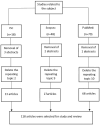Extracellular vesicles and their therapeutic applications: a review article (part1)
- PMID: 38618492
- PMCID: PMC11007590
- DOI: 10.62347/QPAG5693
Extracellular vesicles and their therapeutic applications: a review article (part1)
Abstract
Extracellular vesicles (EVs) have emerged as a captivating field of study in molecular biology with diverse applications in therapeutics. These small membrane-bound structures, released by cells into the extracellular space, play a vital role in intercellular communication and hold immense potential for advancing medical treatments. EVs, including exosomes, microvesicles, and apoptotic bodies, are classified based on size and biogenesis pathways, with exosomes being the most extensively studied. The aim of this study was to examine the molecular secretory pathway of exosomes and to discuss the medical applications of exosomes and the methods for employing them in laboratory models. The therapeutic potential of EVs has garnered significant attention. Their unique properties, such as stability, biocompatibility, and capacity to traverse biological barriers, make them promising vehicles for targeted drug delivery. By engineering EVs to carry specific cargo molecules, such as therapeutic proteins, small interfering Ribonucleic Acid (RNAs) (siRNAs), or anti-cancer drugs, researchers can enhance drug stability and improve their targeted delivery to specific cells or tissues. This approach has the potential to minimize off-target effects and increase therapeutic efficacy, offering a more precise and effective treatment strategy. EVs represent a captivating and rapidly evolving field with significant therapeutic implications. Their role in intercellular communication, targeted drug delivery, and regenerative medicine makes them valuable tools for advancing medical treatments. As our understanding of EV biology and their therapeutic applications continues to expand, we can expect remarkable advancements that will revolutionize the field of medicine and lead to more personalized and effective therapies.
Keywords: Extracellular vehicles (EVs); intercellular communication; regenerative medicine; stem cells; targeted drug delivery; therapeutic proteins.
IJPPP Copyright © 2024.
Conflict of interest statement
None.
Figures


References
-
- Logozzi M, Di Raimo R, Mizzoni D, Fais S. What we know on the potential use of exosomes for nanodelivery. Semin Cancer Biol. 2022;86:13–25. - PubMed
-
- Agarwal S, Agarwal V, Agarwal M, Singh M. Exosomes: structure, biogenesis, types and application in diagnosis and gene and drug delivery. Curr Gene Ther. 2020;20:195–206. - PubMed
-
- Goel A. The era of biomarkers and precision medicine in colorectal cancer: an interview with Ajay Goel. Epigenomics. 2022;14:345–349. - PubMed
Publication types
LinkOut - more resources
Full Text Sources
Research Materials
